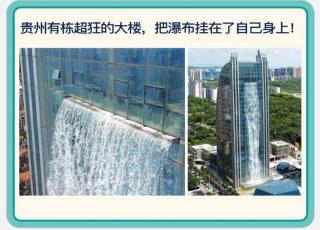
介绍:
1. On this episode, we unveil China’s waterfall building. How would you feel walking down the street to look up and see this? Liebian square in Guiyang City, Guizhou Province in China, has now been put on the map for the world to see.
2. With a running cost of $118 per hour, this unique waterfall feature is only turned on during special occasions. To save money, when itis turned on, they have it set to only run for 20 minutes at a time. To make this urban waterfall happen, they use four 250-horsepower (185-kilowatt) pumps to move the water to the top of thebuilding.
3. Cascading down the side of a skyscraper from 354 feet or 108 meters above, this iconic urban waterfall makes its way into the history books as being the world'stallest man-made waterfall. This system uses tap water but is recycled to an underground storage system.
4. When waterfall was first turned on, residents of the city thought there was a leak in the building and started to alert local newspapers. The creation of the skyscraper waterfall has sparked reactions with mixed reviews. Some people love it while other people think it's a waste of water and electricity.
在本期节目中,我们向大家揭秘中国的瀑布大厦。走在大街上,抬头看到这个,你会有什么感觉?中国贵州省贵阳市的烈变广场现在开始受世人瞩目。
这个独特的瀑布特色的运行成本为每小时118美元,只有在特殊场合才会开启。为了省钱,当它被打开时,他们将其设置为每次只运行20分钟。为了实现这个城市瀑布,他们使用了四台250马力(也就是185千瓦)的水泵,将水输送到建筑物的顶部。
从354英尺(108米高)的摩天大楼侧面倾泻而下,这个标志性的城市瀑布作为世界上最高的人造瀑布而被载入史册。这个系统使用自来水,但会被回收到一个地下储存系统。
瀑布第一次被启动的时候,该市居民以为大楼里漏水,开始提醒当地报纸。摩天大楼瀑布的产生引发了人们褒贬不一的评论。一些人喜欢它,而另一些人认为这是浪费水和电。
大家还在听

